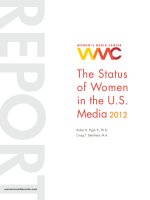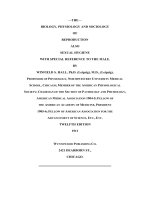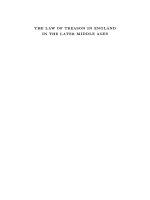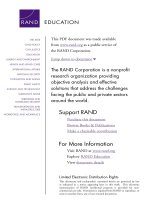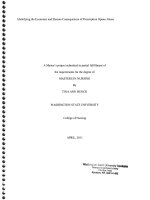The concept of irony in jane austen, with constant reference to virginia woolf
Bạn đang xem bản rút gọn của tài liệu. Xem và tải ngay bản đầy đủ của tài liệu tại đây (493.87 KB, 118 trang )
THE CONCEPT OF IRONY IN JANE
AUSTEN, WITH CONSTANT
REFERENCE TO VIRGINIA WOOLF
Lorraine Yang Zhenping
Thesis submitted in part fulfilment of the requirements for the degree of Master of
Arts (English Studies)
Department of English Language and Literature
Faculty of Arts and Social Sciences
National University of Singapore
Singapore
5 August 2010
Signed Statement
This dissertation represents my own work and due acknowledgement is given
whenever information is derived from other sources. No part of this dissertation has
been or is being concurrently submitted for any other qualification at any other
university.
Signed:……………………
ii
Acknowledgments
I would like to express my sincere gratitude first and foremost to my supervisor, Dr.
Jane Nardin. Her support and patience with respect to my neurotic temperament has
been invaluable, and her feedback always constructive without being judgmental. I
would like to thank also Dr. Susan Ang for prompting me to switch my major from
life sciences to literature when I was an undergrad: this is a debt I cannot repay. In
addition, I would like to acknowledge the importance of my department to this
project: several friends in this department have provided colloquial feedback and
emotional support regarding my work.
I am also indebted to my best friends Bryan Koh and Julia Tay. Bryan has
provided me with endless plates of delicious food throughout the writing of this
whole thesis, as well as always having a sympathetic ear for my problems. Julia has
listened to (irrelevant or even esoteric) rambling about both Jane Austen and Virginia
Woolf, and encouraged me when the writing got rough. I would have never been able
to complete this project without their help. I would also like to express my thanks to
the following friends: Natalia Kutsepova, Juliet O’Keefe, Kwek Hiong Chin and Tan
Yeong Yong.
Special thanks, as usual, go to my indulgent parents, who supported me
throughout the many ups and downs of this project. I really do appreciate the loving
concern: I can only hope that the work justifies all the sacrifices of time and money
that the both of you have made. I also owe a debt to Radiohead, Bach and Glenn
iii
Gould for getting me through many nights of frustration and calming me down when
I panicked. Lastly I would like to thank God for having given me the strength to
complete this.
iv
Contents
Signed Statement
ii
Acknowledgements
iii
Abbreviations
vi
Abstract
1
2
3
viii
Preface
x
Introduction
1
The ??? of Irony
4
Irony in Austen
24
Woolf’s Aesthetics: Art, the Artist and Reality
34
Woolf on Austen
42
Woolf’s Irony: Night and Day and To the Lighthouse
49
Who’s Afraid of Jane Austen?
63
Jane Austen’s Aesthetics
67
Northanger Abbey
78
Mansfield Park
86
Conclusion
96
List of Works Cited
99
Other Works Consulted
107
v
Abbreviations
The various abbreviations constantly used in this thesis are listed below. Full details
of the works can be found in the list of works cited. Anything not listed in this table
can be easily located in the list of works cited without the help of a table.
Abbreviation Used
Author of Work
Unabbreviated Title
JAA
A.Letters
LC
LF
MP
NA
FP
DID
DITN
ROI
ROF
LFDLV
SSP
Jane Austen
Jane Austen
Jane Austen
Jane Austen
Jane Austen
Jane Austen
Jane Austen
Mikhail Bakhtin
Mikhail Bakhtin
Wayne C. Booth
Wayne C. Booth
Jacques Derrida
Jacques Derrida
Journals
TCOI
Søren Kierkegaard
Søren Kierkegaard
IATI
TCI
RJA
Chronology
D.C. Muecke
D.C. Muecke
A. Walton Litz
A. Walton Litz
Jack and Alice
Jane Austen’s Letters
Lesley Castle
Love and Freindship [sic]
Mansfield Park
Northanger Abbey and Other Works
The Female Philosopher
Discourse in Dostoevsky
Discourse in the Novel
A Rhetoric of Irony
The Rhetoric of Fiction
Le Facteur de la Verité
Structure, Sign and Play in the
Discourse of the Human Sciences
The Journals of Søren Kierkegaard
The Concept of Irony With Constant
Reference to Socrates
Irony and the Ironic
The Compass of Irony
Recollecting Jane Austen
Chronology of Composition
AWD
Virginia Woolf
A Writer’s Diary
ABB
Virginia Woolf
All About Books
vi
CIF
Rossetti
Virginia Woolf
Virginia Woolf
Character in Fiction
I am Christina Rossetti
JA1
Virginia Woolf
JA2
Virginia Woolf
JAP
JE & WH
Virginia Woolf
Virginia Woolf
Jane Austen (earlier essay in the period
of 1912-1918)
Jane Austen (later essay in the period of
1925-1928)
Jane Austen Practising
‘Jane Eyre’ and ‘Wuthering Heights’
LFM
MF
MBAMB
Virginia Woolf
Virginia Woolf
Virginia Woolf
Lady Fanshawe’s Memoirs
Modern Fiction
Mr. Bennett and Mrs. Brown
Gaskell
MGC
ND
POF
RASP
Virginia Woolf
Virginia Woolf
Virginia Woolf
Virginia Woolf
Virginia Woolf
Mrs. Gaskell
Mrs. Grundy’s Crucifix
Night and Day
Phases of Fiction
Reflections at Sheffield Place
W.Letters
THOS
LOR
TNOF
TNOH
Virginia Woolf
Virginia Woolf
Virginia Woolf
Virginia Woolf
Virginia Woolf
Selected Letters
The House of Shadows
The Love of Reading
The Novels of E.M. Foster
The Novels of Thomas Hardy
WP
Hazlitt
Virginia Woolf
Virginia Woolf
Winged Phrases
Wm. Hazlitt, the Man
vii
Abstract
Although irony has often been discussed in Austen’s fiction, the understanding of
irony in Austen has been surprisingly simplistic, with many critics arguing that her
irony is stable. Firstly, this can be attributed to the lack of Austen criticism that takes
into account theoretical discussions about irony. Secondly, this view is due to a lack
of consideration for Austen’s aesthetics or a misreading of Austen that sees her
aesthetics as supporting diadactism. This thesis aims to revisit the notion of irony in
Jane Austen by including insights that have been gleaned from the theorizing of
irony. In the process, it hopes to provide a meta-critical explanation to the conflict in
the Austen canon, which involves most critics either as reacting against or supporting
what they think are her views.
In order to get a sense of Austen’s irony, I have compared her aesthetics to
those of Woolf in addition to looking at texts on the concept of irony. I argue that
both Austen’s and Woolf’s use of irony cannot be divorced from their concerns with
realism, which for them consists not of fiction that attempts to replicate external
reality through minute description but rather their treatment of fiction as if it were
reality. I show that free indirect discourse is a crucial feature in generating irony in
Woolf’s and Austen’s texts, arguing that irony in both authors takes the form of an
infinite dialectic. Using the examples of these two authors, I also show that irony is a
method of generating both intellectual and emotional engagement in their fiction. I
viii
hope not only to revision Austen’s aesthetics but also provide an insight into how the
notions of irony and realism operate in the texts of both authors.
ix
Preface
The impulse behind this thesis was simple. I had decided to work on Jane
Austen as I had always admired her writing. While looking through much of the
criticism on Austen’s work, particularly the writing on her irony, I noticed that most
critics tended to see it simplistically: not unlike sarcasm, it was viewed as a tool for
insulting characters whom Austen did not like. Then again, more recent criticism on
Austen’s narrative strategies, I felt, did recognise the ambivalent attitude towards the
characters in many of Austen’s texts. Was irony really so simplistic? And if it wasn’t,
how would it play a part in Austen’s aesthetics? These were questions that haunted
me and required not only research into the notion of irony but also research into
Austen’s aesthetics. It seemed only natural to link the insights into Austen’s narrative
strategies with the concept of irony.
At the same time, I happened, upon re-reading of Austen’s texts, to be
reminded how Virginia Woolf’s own texts operated. As I read more about Virginia
Woolf, I realised that her own aesthetics, as well as her reading of Austen’s texts,
might come in helpful when trying to gain a new perspective on Austen’s aesthetics.
Despite this, I will have to admit that this choice is, to a certain extent, eccentric and
dependent upon my own tastes in literature. Any comparative study, I think, is to a
certain degree arbitrary, and this comparison is no exception, regardless of whatever
similarities lie in the aesthetics and techniques of the two writers. However, an
eccentric study may be a productive one: one only has to consider Bloom’s
x
“Clinamen” in The Anxiety of Influence, which reads Paradise Lost as an allegory for
the writing of poetry. The anachronistic study that I am proposing thus assumes that
the modernist aesthetics of Woolf can build a new critical understanding of irony that
contributes to a new conceptualization of Austen’s aesthetics.
xi
1
Introduction
There is a critical gap in the study of Austen’s aesthetics, and it is highlighted by the
critical response to her irony. Many critical accounts of her irony understand her
irony as stable, that is, reliant on the undercutting of characters’ perspectives through
the narrator’s constant perspective. Given that Austen’s narrator is effaced (through
the heavy use of free indirect discourse), any account of irony as reliant upon the
stability of narratorial views seems insufficient. While there have been some
interesting studies (the most famous of which is Marvin Mudrick’s) done that try to
understand the complex nature of Austen’s irony, many of these are more exploratory
than conclusive: we are only beginning to realise that our critical understanding of
irony in Austen needs updating.
Perhaps the reason for this is the fact that the issues of irony seem outdated in
our current critical climate. Discussions of Austen’s irony were most popular in the
first half of the 20th century. As with most trends in criticism, the numerous Austen
studies on irony soon generated a critical backlash. To many critics, the studies on
irony seemed to be too focused on the structure of the novel, which resulted in the
neglect of its historical context: the central flaw of New Criticism. It is no wonder,
then, that A. Walton Litz’s 1975 article, “Recollecting Jane Austen”, shows a sense
of weariness when he talks about the discussion of irony in Austen: “In their
1
emphasis on irony and dramatic structure, in their aggressively anti-historical bias,
the ‘subversive’ critics and the more austere technicians of New Criticism found a
common ground… Novels are best viewed as autonomous worlds…” (675). Litz is
aggrieved that the focus on irony which was so common in New Criticism seems to
ignore the historical context (RJA 676). However, ignoring the ahistorical aspect of
texts would destroy the radicality of such studies on irony: the provocation that texts
are ahistorical highlights the notion that the meaning of texts need not necessarily
depend on their historical context.1 In fact, ahistoricality is the only reason why we
can read any text at all. Our relation to any written text is always (to varying degrees)
anachronistic, since it is impossible to relate to it at the exact time of writing. We are
always trying to understand the texts we have with the current critical tools we have
in hand: this includes any context of history that we attempt to settle the text in.2
This hypothesis is interesting if we consider that there was a renewed
appreciation for Austen’s work in the early 1900s, particularly by the Bloomsbury
group (Cady and Watt 241). The provocation of this idea is that Austen’s work
decontextualises itself--her style is best understood when read anachronistically as it
is best suited to an age outside itself--in particular the early 1900s. Therefore, this
study intends to compare her aesthetics to those of Virginia Woolf because the
aesthetics of Woolf are concerned with the role of art, the artist and ways of knowing
1
Of course, there are other numerous objections to New Criticism, but it is not within the scope of this
study to deal with those. For more information, see Mark Jancovich’s The Cultural Politics of the New
Criticism.
2
I need hardly mention, of course, that the notion of history and the perception of past events are
subject to the forces of history as well. The context is always-already contextualised.
2
the world, the effectiveness of art in portraying reality, and the role of the reader.
These are issues that (as I will show) Austen was very concerned with in her writing.
Thus, a comparative study might provide insights into how irony in Austen relates to
issues like epistemology and the role of art in one’s life. The modern critic has tools
for understanding irony that many of the critics in New Criticism did not use: namely,
a corpus of theoretical writings that attempt to explicate the phenomenon of irony.
This study thus attempts to revive the discussion of Austen’s irony by using irony
theory to compare her irony to that of Woolf’s, arguing in the process that Austen’s
irony resembles that of this prominent modernist.
In order to argue this, it is necessary to give an overview of the treatment of
irony in the critical canon as well as a brief discussion of the nature of irony. While it
is certainly true that much of criticism is dependent upon the views of the critic
writing it, I would like to suggest that history of strong and varied responses to
Austen’s work might be an indication of how her use of irony encourages such
contentious, or even mutually exclusive readings of her texts. The next section on
irony will discuss some of the criticism that has been written on irony. Then, I will
demonstrate how the current critical understanding of irony, when read together with
Austen’s texts, leads to disagreements about the Austen canon. In the course of the
discussion, it will become clear that the texts themselves require a more incisive
understanding of irony that builds upon the insights of some 21st century criticism.
Both sections will argue for a revisioning of these notions which take into account the
complexity of Austen’s aesthetics, building towards the last section, which argues for
3
a comparison of Austen’s aesthetics with those of Woolf so as to facilitate the
construction of an aesthetic framework that adequately explains and takes into
account her views on irony and aesthetics. This study therefore intends to investigate
possible ways of conceptualizing Austen’s irony in order to construct a critical
framework that revisions the two features in relation to the complexity of Austen’s
art.
The ??? of Irony
It is extremely uncomfortable for a critic to be dealing with the phenomenon
(if one can call it that) of irony. On the one hand, so much has been written on the
subject that one feels obliged to collect as many accounts of irony as possible. On the
other hand, there is an awareness that the collection of such accounts is an implicit
admission that the concept is difficult to pin down. The most distressing thing about
these accounts of irony is that they all seem to make sense on an intuitive level even
as they disagree with one another. In short, one can say about irony what Freud says
about wit:
[The] criteria and attributes of wit mentioned by these authors… seems to us, at
first glance, so very pertinent and so easily demonstrable by examples that we
cannot succumb to the danger of underestimating the value of such ideas. But they
are only disjointed fragments… In the end, they contribute no more to the
knowledge of wit than a number of anecdotes teach us of the true characteristics of
a personality whose biography interests us (605).
One can clearly see the irony in all of this, which is part of the problem: the
proliferation of accounts shows that no one has managed to account fully for wit.
This in turn generates more accounts that attempt to account for wit: if one wants to
4
be technical and put it in psychoanalytic terms, then one can say that there is a
constant lack at the heart of the concept which accounts of irony attempt to screen.
But let us look again at the first part of my sentence: “one can clearly see the irony in
all of this.” I know this is a clearly ironic phenomenon, but when it comes to
explaining why, things become a little difficult. Samuel Johnson’s attempt at
explaining irony does not clarify matters very much: “A mode of speech of which the
meaning is contrary to the words” (Johnson, cited in Enright 5).3 A much more
modern dictionary, the Oxford English Dictionary, has a much longer definition of
irony with about the same amount of success:
A figure of speech in which the intended meaning is the opposite of that expressed
by the words used; usually taking the form of sarcasm or ridicule in which
laudatory expressions are used to imply condemnation or contempt. An instance of
this; an ironical utterance or expression. fig. A condition of affairs or events of a
character opposite to what was, or might naturally be, expected; a contradictory
outcome of events as if in mockery of the promise and fitness of things. In
etymological sense: Dissimulation, pretence; esp. in reference to the dissimulation
of ignorance practised by Socrates as a means of confuting an adversary. spec. in
Theatr. (freq. as dramatic or tragic irony), the incongruity created when the
(tragic) significance of a character's speech or actions is revealed to the audience
but unknown to the character concerned; the literary device so used, orig. in Greek
tragedy; also transf. (database online).
It is even more confusing to find a paragraph by Freud which attempts to
differentiate wit from irony when his summation of the writings on wit parallels the
critical corpus of writing on irony: “The essence of irony consists in imparting the
very opposite of what one intended to express, but it precludes the anticipated
3
This definition of irony is simplistic, and does not take into account the many different types of irony.
At risk of categorising, Johnson is talking only of a particular type of verbal irony: he does not take
into account situational irony or dramatic irony. Of course, such classifications only lead us into some
trouble, as I will show later.
5
contradiction by indicating… that the speaker himself means to convey the opposite
of what he says” (725). It seems, then, that Freud is in agreement with Johnson, but
the definitions of irony from the two writers are narrower than the senses elaborated
in the Oxford English Dictionary. Of course, this is merely the tip of the iceberg: we
have not even begun to look at the thousands of books that specifically concentrate on
explicating the concept.
Of course, several critics who write on irony are aware of the problem, but
continue bravely soldiering on anyway. D.C. Muecke opens his book The Compass of
Irony by saying:
Getting to grips with irony seems to have something in common with gathering the
mist; there is plenty to take hold of if only one could… Yet if, upon examination,
irony becomes less nebulous, as it does, it remains exclusively Protean. Its forms
and functions are so diverse as to seem scarcely amenable to a single definition…
(TCI 3).
He goes on to note that “irony, like beauty, is in the eye of the beholder and is not a
quality inherent in any remark, event or situation” (TCI 12). Since this apparently is
the case, Muecke’s solution would be to catalogue as many definitions of irony as
possible. He operates on two assumptions: firstly, that irony would become less
amorphous upon closer examination and that secondly, one would be able to
catalogue the number of forms that this “Protean” phenomenon takes. Doing this, of
course, is like trying to enumerate all the possible shapes that water can take by
attempting to take into account any thing that could act as a container for it. In short,
it strikes one as somewhat futile and ironic because (as earlier mentioned) Muecke is
6
simply proving that irony might be “nebulous” after all.4 Incredibly, Muecke
generates a long list not only in this book but continues the task in another book,
titled (ironically?) Irony and the Ironic.
Muecke is, of course, not alone. In his article, “Approximately Irony,”
Jonathan Tittler decides that he has to do a similar accounting of irony (to account for
it): “If irony is not to be crushed under the weight of its own protean polymorphism,
it must be set forth systemically” (32). And just like Muecke, Tittler insists on
carrying on despite the futility of his task: “[Even] if totalization is impossible
(because irony is the essence of unachieved totalization), we are at present so far
from threatening that limit, surely much can be gained from a rigourous failure” (32).
Similar conclusions have prompted critics like Wayne Booth, Linda Hutcheon and
D.J. Enright to try to record all the different forms (or at least, most of the different
forms) of irony that are currently in use.
If forming a list of the different types of irony is not the most feasible
approach towards understanding the phenomenon, then what is? Many other critics
attempt instead to find out what the essence of irony is, that is, to find out what
characterizes all things called “ironic.” The most famous of these studies is Søren
Kierkegaard’s seminal book titled The Concept of Irony, written in 1841. Kierkegaard
does not generate an exhaustive list of the different kinds of ironies that might arise in
4
See, this is the problem. One knows it is ironic, but talking about why it is so is difficult, if not
impossible. The irony here might be deemed “situational” – if one wants to classify – the critic is in the
position of Oedipus (but does that mean that situational irony is akin to dramatic irony? The problems
begin).
7
different kinds of texts and/or situations in life. Instead, Kierkegaard clearly finds this
sort of cataloguing distasteful. Such exhaustive lists of how irony can be defined are,
in fact, why he thinks his study is important: “As philosophy cannot be indifferent to
the subsequent history of this concept, so neither can it content itself with the history
of its origin, though it be ever so complete and interesting a history as such.
Philosophy requires something more…” (TCOI 48). Instead of listing the various
kinds of ironies that might exist, Kierkegaard tries to find out what characterizes
irony by examining Socrates, whom he calls is the very first ironist in the world
(TCOI 47).
The difference between the approaches stems from the fact that critics like
Muecke view irony mainly as a rhetorical device and not anything connected to a
method of reading or world-view. Muecke refuses to accept the idea of irony as
epistemology mainly because the thought that everything could be ironic seems like a
possibility that makes art dull: “Moreover, the non-ironic is not necessarily alazonic;
that is to say, there are occasions in life and art, let us hope, when irony is not called
for. What then are these occasions from which we would hope to exclude irony, if
only to preserve some variety in life and art?” (IATI 4-5). It seems that Muecke
believes that viewing everything with the potential to be ironic simply means that one
would ignore the huge variety that art presents us with. Because of this, he wants to
reduce a philosophical view of irony to merely a way of viewing irony (in other
words, he would like to see it as yet another number on his list). I think, however, that
Muecke thinks this because he unwittingly (and ironically, for someone making a list
8
of ironies) presupposes that the concept of irony is reductive: for Muecke, it seems
that the notion of irony as a method of reading would mean that all texts would end
up being understood in the same way. Even if irony is a method of reading, this in no
way makes all texts similar to one another. There is the fact that even ironic readings
of the same text differ from one another because they pick up on different aspects of
the texts. Lastly, irony would operate in different ways for different texts.
Oddly enough, Muecke’s fear that the complexity of “irony” will cause the
term to “follow into limbo the concept of ‘sublimity’” is the one of the few things in
his text that gives us a key to understanding what “irony” may be. At this point, I
would like to compare the problem of defining irony with Jean François Lyotard’s
explication of the sublime:
The sublime… takes place… when the imagination fails to present an object which
might, if only in principle, come to match a concept. We have the Idea of the
world… but we do not have the capacity to show an example of it… Those are
Ideas of which no presentation is possible… They can be said to be unpresentable
(43).
One can try to describe the sublime, but its power comes from the realm of the
unpresentable. It strikes me that irony might operate in the very same way. This
would explain why irony, like the sublime, has become an overdetermined term: both
terms attempt to describe a powerful affect of textuality which cannot be described
fully in language precisely because it is, to some extent, beyond cognition.
Note Kierkegaard’s wonderful description of how ironic discourse operates in
Socrates:
9
There is an engraving that portrays the grave of Napoleon. Two large trees
overshadow the grave. There is nothing to be seen in the picture, and the
immediate spectator will see no more. Between these two trees, however, is an
empty space, and as the eye traces out its contours, Napoleon himself suddenly
appears out of the nothingness… There is not a single syllable to give any hint of
another interpretation, just as there is not a single brush stroke to suggest
Naploeon. Yet it is this empty space, this nothingness, that conceals what is most
important (TCOI 56-57, emphasis mine).
The notion that irony is precisely this nothingness that veils ideas is crucial to our
understanding. Muecke’s complaint that “getting to grips with irony seems to have
something in common with gathering mist” (as quoted earlier in The Compass of
Irony) tells us more about irony than any of his lists. It explains why irony seems to
be “infinitely elastic,” in Kierkegaard’s words (TCOI 63). One of the potencies of
irony, Kierkegaard notes, “lies in formulating a theory of knowledge which
annihilates itself” (TCOI 98). Thus, the more one theorises about irony, the more
likely this theorizing is to go wrong because irony, like mist, cannot be pinned down.
It oscillates endlessly between the two poles of a dialectic. The oscillatory movement
itself is irony. Hence, differentiating irony into types only worsens the problem
because the many definitions of irony provide an endless number of “poles” between
which irony can jump. This is why the many types of irony seem to blend into one
another while retaining a common something that is recognizable as irony. As
Kierkegaard says, irony “is a nothingness which consumes everything and a
something which one can never catch hold of, which both is and is not… it also
succumbs to itself, since it constantly goes beyond itself while remaining in itself”
(TCOI 161).
10
According to Kierkegaard, then, irony is a standpoint of one never taking a
stand. It involves the ability to distance one’s self from the phenomenon that one
investigates in order to try and reduce the phenomenon to a completely abstract
concept, thus voiding all emotional attachment that one has to earthly things:
What characterizes irony most perfectly is the abstract criterion whereby it levels
everything, whereby it masters every excessive emotion, and hence does not set
the pathos of enthusiasm against the fear of death (TCOI 115).
[Irony’s] relation to the Idea is negative, that is, the Idea is the limit of the
dialectic. Constantly engaged in leading the phenomenon up to the Idea (the
dialectical activity), the individual is thrust back, or rather, flees back into
actuality. But actuality itself has no other validity than to be the constant occasion
for wanting to go beyond actuality—except that this never occurs. Whereupon the
individual draws these exertions (molimina) of subjectivity back into himself…
Such is the standpoint of irony (TCOI 183)
That is, Kierkegaard analogizes the movement of irony to the dialectical movement in
Hegel’s thought, except that irony has a negative end while Hegel’s dialectic has a
positive end. While Hegel’s dialectic terminates in the Absolute, irony simply is a
series of infinite negations, never reaching any stable position precisely because it
undermines everything.
Because of this infinite negativity, Kierkegaard disapproved of irony, or at
least irony as perceived as Socrates’ standpoint (which I have been elaborating on)
and later as understood by the Romantics, Fichte and Friedrich Schlegel. He felt that
irony confused the metaphysical actuality with the historical actuality because the
metaphysical is atemporal: “Irony had sprung from the metaphysical problem
concerning the relation of the Idea to actuality, but metaphysical actuality is beyond
time, hence it was impossible for the actuality desired by irony to be given in time”
11
(TCOI 295). In other words, Kierkegaard notes that irony is always chasing after the
idea, which is immutable and cannot be obtained, just like the reality outside Plato’s
cave. However, since we live within time, any versions of the idea would be
influenced by its historical (and cultural) context. Therefore, irony discards all
positivity because “[it] knows that the phenomenon is not the essence” (Kierkegaard,
TCOI 296).
Kierkegaard is therefore right in noting that irony is a moment that involves
endless oscillations between the two poles of a dialectic: it is the moment in time
when disjuncts between ideas are realised and performed (TCOI 295). Nevertheless, I
am not sure that irony is empty or is nothingness simply because it is engaged in a
futile chase after the idea. Rather, it seems that irony is an acute awareness of any sort
of disjunction. If this is the case, and irony is the oscillating movement between these
disjuncts, it does not necessarily mean that irony is necessarily directed towards a
vanishing endpoint of the idea. The movement itself is not directed towards anything.
Rather, it is a function of criticality: “the ironic orientation is essentially critical”
(Kierkegaard, TCOI 293). Kierkegaard assumes that criticality must be directed
towards obtaining the transcendental truth (as with Hegel), which is the reason why
he does not approve of the infinity that the endless dialectic of irony represents.
This, however, is not necessarily true. Kierkegaard dislikes irony because he
dislikes the cycle of endless negativity and desires that the individual, using irony,
reach a positive conclusion:
Irony is like the negative way, not the truth but the way (TCOI 340).
12
Irony as a mastered moment exhibits itself in its truth precisely by the fact that it
teaches us to actualise actuality… This cannot mean that it… [denies] there is, or
at least there ought to be, in every human being a longing for a higher and more
perfect. But this longing must not hollow out actuality; on the contrary, the content
of life must become a true and meaningful moment in the higher actuality whose
fullness the soul desires. Actuality in this way acquires its validity… (TCOI 340341).
However, as Gary Handwerk notes, “it is actually Kierkegaard who remains locked
into an individualist model of discourse… Irony must… be condemned because it
falls short of attaining a fully unique and individual personality” (9). While
Kierkegaard disapproves of irony because he sees its dialectic as futile, Handwerk
argues through his reading of Schlegel that the constant movement between positions
that constitutes irony “operates as an opening out to the other” (42).5 Because irony is
a critical attitude, its constant undermining of its own position allows for new
possibilities, ideas and concepts that are other than itself.
Schlegel pushes Socratic irony to its limits by proposing that the infinite
negativity of Socratic irony is still bounded by one limit: the self. As Handwerk says,
“this negating irony is an expression of the ironist’s realization that he, too, is caught
up in the process of interpretation and can never attain a position outside itself or
himself” (39). This realization, however, pushes the ironist to become open to
possibilities outside of himself. Thus, irony is, for Schlegel, not only negative but
5
Most studies, for example, Claire Colebrook’s Irony, view Romantic irony as something dependent
on the transcendental ego. In this model, the dialectic of irony is united only in the artist’s imagination.
There is, hence, a tendency to attribute a sort of omniscience to the artist: an infinite capability to
create. Handwerk is aware of this, and works against this reading of the Romantic understanding of
irony explicitly, as should be obvious from my explication of his writing.
13
positive, as to remain fixated on one unchanging Idea requires the ironic subject to
reject anything concrete (where the concrete is other to the self fixated on the ideal):
“An idea is a concept perfected to the point of irony, an absolute synthesis of absolute
antitheses, the continual self-creating interchange of two conflicting thoughts. An
idea is at once idea and fact” (33). Thus, it seems that Kierkegaard, perceptive as he
was, did not give Schlegel full credit for his understanding of irony. This is
understandable, as Kierkegaard, who was writing under Hegel’s shadow, was
influenced by Hegel’s dislike of negativity.6 If one wants to consider irony in terms
of ethics, then irony need not necessarily be entirely solipsistic. Somehow,
Kierkegaard did not realize that if “[irony’s] actuality is sheer possibility,” then
historical actuality (the “fact,” as Schlegel says) might merely be one of those
possibilities (TCOI 296). Irony’s dialectic, therefore, does not move further and
further away from actuality into the idea. Rather, its dialectic movement takes into
account the possibility that any given actuality might be an idea, and vice versa.
It is perhaps notable that Schlegel, for all his perceptiveness, was recognized
more for his literary contributions than philosophical ones (Allen, database online).
6
Hegel might characterise irony as generating a “‘bad infinity,’ which names an accumulation without
limits, one that adds on indefinitely to itself, but whose additions never alter the whole” (Levinson 67).
For Hegel’s take on Socratic irony, see “Hegel’s Conception of Socrates” in The Concept of Irony
(Kierkegaard, trans. Lee Capel, Indiana University Press, 241-256). It should be noted that
Kierkegaard’s text is, itself an ironic work, and hence his support of Hegel was necessarily equivocal.
While, like Hegel, he disapproved of the negativity in Socrates, he rebelled against Hegel (even then –
this was his university thesis!) in insisting that Hegel misunderstood how Socrates treated the
universal.
14


